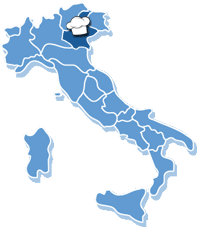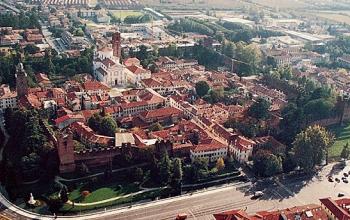
About Castelfranco Veneto
Among the smaller centres of the district, Castelfranco Veneto is considered to be one of the most interesting because of its rich historical background and its perfect geographical position, very near to important towns like Treviso, Venice, Padova and Vicenza, and other well-known tourist attractions like Cittadella, Asolo, the enormous Mount Grappa, the piedmont hills and Montello.

The rise of Castelfranco can be traced back to the end of the 12th Century when the commune of Treviso, in order to defend its western boundaries from the threats of the inhabitants of Padova, Vicenza and the feudal gentlemen of the area, decided to build a fortress near the village of the new Pieve river and the tiver-torrent Muson. At the same time the rulers of Treviso conceded special taz exemptions (the name Castelfranco is derived from this as “franco” means “free”) and economic advantages to the people who agreed to go and live there and assume the responsibility of defending the fort. The castle, still very well preserved, was square-shaped, with a perimeter of about 930 metres and solid towers placed at the corners and the centre of each side of its walls, which are 7 metres high. There were two main entrances, facing Treviso in the East and Vicenza in the West, respectively.
As time passed, the military functions of the town declined, while it increased in importance as an economic and cultural centre. This is testified by the rising of numerous elegant buildings in the urban area and the countryside, where noble Venetians began to build some beautiful villas (The “Marca”, or zone of Treviso, and with it Castelfranco, passed to the Republic of S. Marco in 1339).
Some famous citizens of Castelfranco are the great artist Giorgione (1477 or 1478-1510), the musician Agostino Steffani (1654-1728) and the architect Francesco Maria Preti (1701-1774).
“Mummy's Boys”
“The rough charm of the unshaven Italian Lathoario mounted jauntily on his Vespa is an inescapable image, one redolent of the Latin lover. The truth is perhaps a little less alluring.
According to figures published in 1997 by Istat (Istituto Centrale di Statistica), the country's main statistics body, Italian men actually constitute an esercito di mammoni (army of mummy's boys). Forget Oedipus, these boys know which side their bread is buttered. Perhaps they are not so different from men world over, but the numbers are certainly telling.
If you can believe the Istat, 66.5% of single Italian men remain at home with mum (and dad) at least up to the age of 34. Granted, this is partly caused by problems of unemployment, the cost fo housing and so on. Of the remainder who do move out of home, some 42% of those aged up to 65 do not shift more than 1 km away and only 20% dare to move more than 50 km beyond the maternal home. Of all these "independent" single men, 56% manage to stop by mum's place every day of the week. The unkind might be led to believe (as was the author of at least one newspaper story on the subject) that, apart from filial devotion, the lads might well bring with them a bag of dirty washing and time the visit to coincide with lunch.”
Quote from Lonely Planet Italy, 5th Edition, page 61